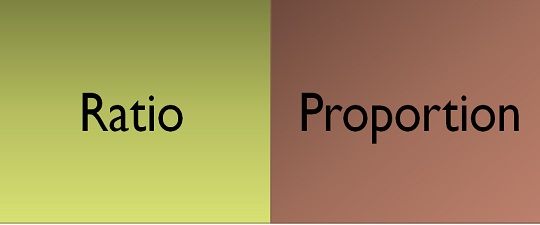Overview
Ratio and proportion are largely explained using fractions. When a fraction is expressed as a:b, it is a ratio, while a proportion expresses the equality between two ratios. In this case, a and b may be any two integers. Ratio and proportion are two critical concepts, and they serve as the basis for understanding many concepts in mathematics and science.
We use the principle of ratio and proportion in our everyday lives, for example, in business when dealing with money or when preparing some meal. Occasionally, students become perplexed by the concepts of ratio and proportion for class 6. The aim of this article is to provide students with a better understanding of these two principles through the use of additional solved examples and problems.
For instance, if the ratio is 4/5, the proportion statement is 20/25 = 4/5. When we solve this proportional statement, we obtain the following:
- 20/25 = 4/5
- (20X5) = (25X4)
- 100 =100
Thus, the ratio expresses the relationship between two quantities, such as a:b, where b is greater than zero. For instance, the ratio of two to four is denoted as 2:4 = 1:2. And the statement is said to be proportionate in this instance. Direct proportion can be used as an implementation of proportion.
Difference between Ratio and Proportion in Mathematics:
This section defines the terms ratio and proportion. Both definitions are critical components of mathematics. Additionally, there are numerous instances in real life, such as the rate of speed (distance/time) or price (rupees/meter) of a commodity, where the ratio principle is illustrated.
Proportion is an equation that establishes that two given ratios are equal. For instance, the time required for a train to travel 100 kilometres per hour is the same as the time required for it to travel 500 kilometres in five hours. For example, 100 kilometres per hour equals 500 kilometres in five hours.
Ratio Definition:
In certain circumstances, comparing two quantities using the division method is extremely effective. We may assume that the ratio is the contrast or condensed form of two identical quantities. This relationship indicates the number of times one quantity is equal to the other. To put it simply, a ratio is a number that can be used to express one quantity as a fraction of another. Only when the two numbers in a ratio have the same unit can they be compared. Ratios are used to equate two items. A ratio is denoted by the symbol ‘:’.
A ratio can be expressed as a percentage, for example, 2/5. In our everyday lives, we encounter several similarities, or ratios.
Important Points to Bear in Mind:
- There should be a ratio of quantities of the same kind.
- When comparing two products, the units used should be comparable.
- There should be a clear hierarchy of words.
- Comparing two ratios is possible if the ratios are equal, as fractions are.
Proportion Definition:
Proportion is an equation that establishes that two given ratios are equal. In other words, the proportion indicates that the two fractions or ratios are identical. When two sets of given numbers increase or decrease in the same ratio, the ratios are said to be directly proportional. For instance, the time required for a train to travel 100 kilometres per hour is the same as the time required for it to travel 500 kilometres in five hours. For example, 100 kilometres per hour equals 500 kilometres in five hours.
Ratio and proportion are sometimes referred to as two sides of the same coin. When the values of two ratios are identical, they are said to be in proportion. To put it simply, it contrasts two ratios. The symbol ‘::’ or ‘=’ denotes proportions.
Formula for Proportion:
Assume now that the two ratios are a:b and c:d are in proportion. The words ‘b’ and ‘c’ are referred to as ‘means or mean terms,’ while ‘a’ and ‘d’ are referred to as ‘extremes or extreme terms.’
a/b equals c/d or a: b:: c: d
As an illustration: Consider another scenario with a large number of students in a classroom. If the first ratio of girls to boys is 3:5 and the second is 4:8, the proportion can be written as follows:
3 : 5 : 4 : 8
Three and eight are the extremes, while five and four are the means.
For more examples and video solutions explore the best online learning website in India.

